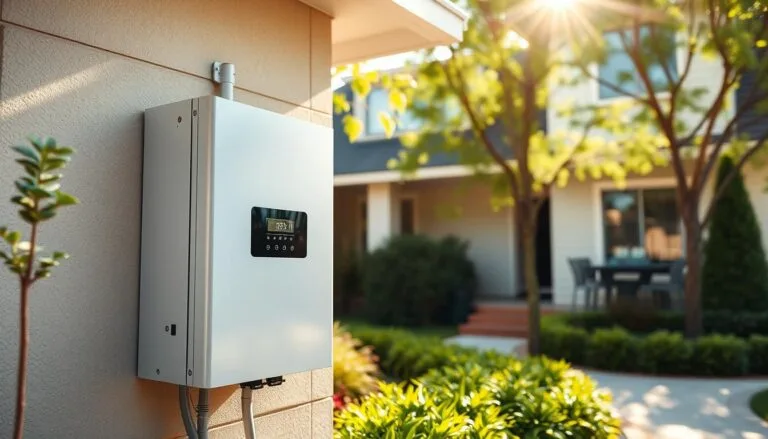Make your home cleaner and more resilient today. In 2025, the average U.S. residential installation costs about $21,816 before incentives — roughly $3.03 per watt. The 30% federal tax credit can cut that upfront expense and change the math for many households.
Choosing the right solar panels and system matters more than chasing the lowest sticker price. Brands like VSUN, Hyundai, JA Solar, Trina, and Mission Solar show that lower per-watt pricing can still deliver solid warranties and real performance.
This buyer’s guide will walk you through current panel pricing, how incentives work, and which equipment blends cost and efficiency. You’ll learn to compare quotes, value installation quality, and focus on long-term savings and electricity resilience.
Solar is momentum. Each installed kilowatt adds household power and helps move the grid toward cleaner energy. By the end, you’ll have clear steps to choose panels and build a system that fits your goals.
Key Takeaways
- The 2025 average cost is about $3.03/W before incentives; the 30% federal tax credit reduces upfront cost.
- Select panels and system design together — warranty and installation quality shape results.
- VSUN, Hyundai, JA Solar, Trina, and Mission Solar offer budget-friendly, reliable options.
- Compare quotes on total system value, not just panel price per watt.
- Focus on efficiency, performance, and long-term savings for real benefits today.
Why affordable solar technology matters right now
Today’s rooftop panels deliver far more energy per square foot than models from a decade ago. Most modern residential units now exceed 20% efficiency, and premium panels top 22%. That means a smaller array can generate the same power, making installations more practical for many homes.
The 30% federal tax credit also changes the math. Homeowners can subtract thousands from their federal tax bill, bringing the project within reach in varied market conditions.
Comparing multiple quotes often cuts installed prices by roughly 20%. Where net metering exists, exporting excess electricity speeds payback and grows lifetime value. As retail electricity rates rise, locking in local generation offers steadier costs and clear savings.
This is no longer a niche option. Competitive equipment choices and transparent bids mean more homes can choose dependable systems that balance cost, performance, and warranty. Every installed array also helps clean the air and strengthen the grid — practical home decisions that deliver community benefits today.
- Efficiency gains: more energy per panel
- Policy support: 30% federal tax credit
- Market tools: multiple bids and net metering shorten payback
The real cost of going solar in the United States today
A headline $/W number hides many choices that shape lifetime savings and performance. Understanding per‑watt math helps you compare true value across quotes and designs.
Price per watt explained
At about $3.03 per watt, a 7.2 kW example totals roughly $21,816 before incentives. That simple example shows how system size and price drive the headline cost.
Some brands push below $3/W: VSUN (~$2.92/W), Hyundai (~$2.93/W), JA Solar (~$2.94/W), Trina (~$2.95/W), Mission Solar (~$2.97/W). Cheaper module prices can trim equipment line items, but they touch only part of the bill.
What actually drives total costs
Panels make up roughly 12% of a project. The rest is inverters, racking, wiring, labor, permitting, and other balance‑of‑system items. Roof complexity and installer rates add variability across the market.
How incentives cut costs
The 30% federal tax credit applies to the entire installed price, lowering tax liability by thousands. Stacking local rebates or performance programs can speed payback and boost net savings.
- Tip: Use per‑watt consistently to compare quotes.
- Value note: Well‑matched inverters and quality installation often beat the cheapest panel option for lifetime energy and warranty support.
How to choose an affordable system that fits your home and energy needs
Begin with the site: your roof size, shade patterns, and future needs should guide every component choice. A clear site plan saves money and boosts long‑term value.
Roof, shade, and space
Measure usable roof area and note shading at different times of day. That decides how many panels you can place and whether higher‑watt modules or compact arrays work best.
Climate and real‑world performance
Check temperature coefficients: output drops for each °C above 25°C (for example, about -0.35%/°C). In hot regions, prefer modules and racking that improve airflow to protect performance.
Sizing for usage and goals
Use a year of bills to size the system for savings, backup, or EV charging. Plan extra capacity or conduit routes now if you expect future electrification.
Warranties, degradation, and electronics
Compare warranties and degradation rates (typically 0.3%–0.8%/year). Shade‑prone roofs often benefit from microinverters or DC optimizers. PERC or bifacial cells can add production in the right layout.
- Tip: Prioritize documented performance and support over the lowest sticker price.
- Tip: Leave room for batteries or extra panels later.
Best picks in affordable solar technology for 2025
When rooftop space is tight, selecting higher-output modules changes the whole project. Below are concise brand snapshots and quick price context to help you match goals to real-world performance and warranty terms.
Brand snapshots: quick pros and cons
- VSUN — High-watt modules (VSUN460N‑96BMHR‑D ~ $2.92/W). Fewer panels per array, which helps on smaller roofs.
- Hyundai — HiS‑S410YH(BK) ~ $2.93/W. 25-year warranty and monocrystalline bifacial cells for extra edge-on output.
- JA Solar — JAM54D40‑460/LB ~ $2.94/W. Up to ~23% efficiency for max energy per square foot.
- Trina — Vertex S TSM‑NEO9RC.05 ~ $2.95/W. Strong PVEL reliability testing and steady field ratings.
- Mission Solar — MSE PERC 108HC ~ $2.97/W. 25-year warranty and American‑made appeal.
Price comparison by system size
Use a 7.2 kW example to compare impact. Modules at ~ $2.92–2.97/W trim equipment costs modestly, since panels are ~12% of total system cost.
Reality check: even a sub‑$3/W module reduces upfront price only a little. Design, labor, and balance‑of‑system items drive most cost and long‑term performance.
When “cheap” is smart
Smart cheap means reputable brands, clear warranties, and documented testing. Prioritize proven performance over unknown imports.
Get at least three quotes to pressure‑test the market. Match brands to goals—max output, heat resilience, or domestic manufacture—and choose the mix that fits your home and energy plan.
Efficiency and panel technology: getting more power per square foot
When roof area is scarce, every percentage point of efficiency turns into real annual kilowatt‑hours. Most residential panels now clear 20% efficiency, while premium modules exceed 22% and squeeze more output from limited space.
Understanding efficiency ratings
An efficiency rating shows how much sunlight a panel converts into electricity. 20%+ is common today; 22%+ marks premium performance like Maxeon’s 22.8% 440 W module.
Mono, poly, thin‑film, and bifacial: which fits your roof?
Monocrystalline delivers top output density and is the go‑to for tight roofs. Polycrystalline costs less but needs more area.
Thin‑film suits lightweight or curved surfaces but gives lower efficiency. Bifacial panels can add production when rear reflections are available.
Top high‑efficiency brands and trade‑offs
Leaders include Maxeon, Qcells, Canadian Solar, REC, and Panasonic. Higher efficiency often costs more up front, yet it can unlock better lifetime value when space or shading limits your array size.
- Temperature matters: REC and Panasonic show strong temperature coefficients, so they hold output better in heat.
- Under the glass: PERC, half‑cut cells, and higher busbar counts reduce losses and boost real‑world performance.
- System match: Pair high‑efficiency panels with the right inverter and tilt to realize their full power potential.
For a quick primer on leading module efficiency in the market, see this guide on the most efficient panels: most efficient solar panels.
Seven smart ways to save money on your home solar system
A few strategic moves—timing, quotes, and net metering—often deliver bigger savings than a single low price. Use these practical steps to cut upfront cost and boost long‑term savings for your home solar project.
Use net metering to convert surplus into bill credits
Net metering lets daytime surplus offset evening usage. Where it exists, exported power reduces your monthly bill and speeds payback.
Compare multiple quotes to lower installed price
Get three or more bids. Different crews and parts change total price a lot. Comparing quotes often trims installed cost by about 20% and uncovers better warranties, inverters, and panel choices.
Go incremental: portable kits, used panels, and community options
Start with small systems like portable generators or RV kits to gain experience without full rooftop work. Refurbished panels can be a DIY/off‑grid option.
Community solar subscriptions are another path—save money and cut bills without installing anything on your roof.
Stack incentives and smart financing
Combine the 30% federal tax credit (many homeowners see ~ $6,500) with state rebates and utility programs. Choose financing that keeps lifetime cost low and aligns with your cash flow.
Time upgrades and plan for expansion
If you’ll reroof or add batteries, coordinate now. Bundling work saves labor and rework. Leave conduit and space so adding an EV charger or battery later costs less.
Monitor performance and protect your savings
Use app monitoring to spot drops early. Quick fixes keep production high and prevent lost bill savings over years.
“A well‑timed decision and three good quotes often beat a single cheap offer.”
- Tip: Match panels and inverters for the best energy yield.
- Tip: Track bills monthly to verify expected savings.
- Tip: Ask installers about stacking local rebates in writing.
From quote to switch‑on: components, installation, and quality checks
A well‑built rooftop system starts with clear hardware choices and a clean installation plan. Map the core pieces so you know how panels, inverters, racking, wiring, and optional batteries work together to deliver safe electricity to your home.
Core components
Panels and panel type: choose modules with proven ratings and documented degradation over the years.
Inverters: string inverters reduce costs on simple roofs; microinverters or optimizers protect output on shaded or complex layouts.
Balance of system: racking, wiring, charge controllers (for hybrid setups), and batteries complete a durable system.
Installation factors that impact performance
Design orientation and tilt to match latitude. Minimize wire runs and plan airflow under the array for heat relief.
Address shading with layout or module‑level electronics to preserve energy and power during partial shade.
Quality assurance and ownership
- Verify certifications and third‑party test results (PVEL, IEC) and request spec sheets.
- Prioritize 25‑year product and performance warranties and record serials for future claims.
- Own your data: enable monitoring to spot drops early; schedule simple cleaning for dust or snow by season.
“A few quality checks at install time save years of production headaches.”
Before you sign, get multiple bids and compare total value — not just panel price. For help on comparing offers, see this guide on comparing solar quotes.
Conclusion
A well‑chosen panel lineup and thoughtful system design turn rooftop potential into steady household savings.
With mainstream modules now clearing 20% efficiency and strong incentives in place, solar panels offer a clear path to dependable power and real bill reduction. Match options to your energy needs, roof constraints, and budget so the system meets long‑term goals.
Value runs deeper than sticker price: reputable brands, solid warranties, and careful design convert kilowatts into reliable electricity over decades. Pick monocrystalline for top power density or trusted value brands when price and performance must balance.
Ready to act? Gather three quotes, compare projected production and payback, and choose the lineup that fits your home energy needs. Every well‑built array adds clean power to the grid and brings your household closer to energy independence.
























